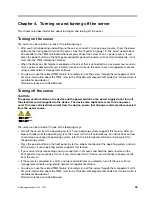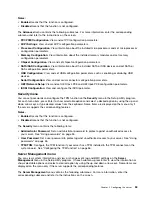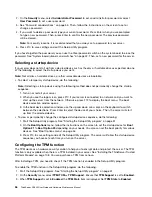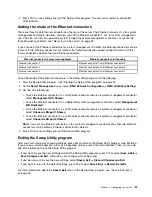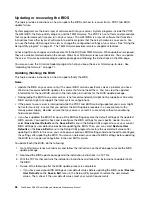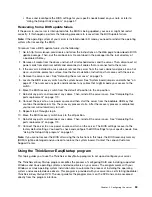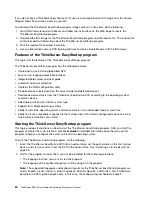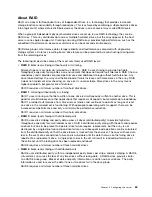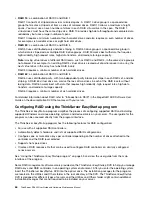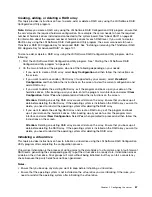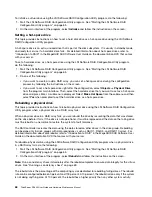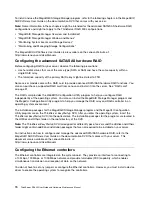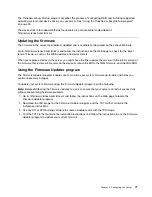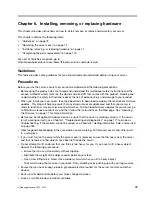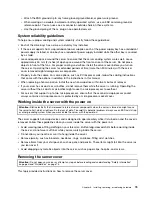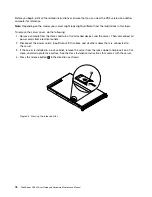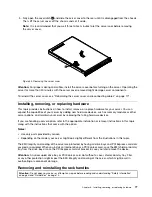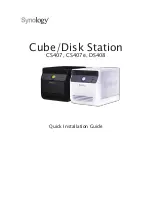
About RAID
RAID, an acronym for Redundant Array of Independent Disks, is a technology that provides increased
storage functions and reliability through redundancy. This is achieved by combining multiple hard disk drives
into a logical unit, where data is distributed across the drives in one of several ways called RAID levels.
When a group of independent physical hard disk drives are set up to use RAID technology, they are in a
RAID array. This array distributes data across multiple hard disk drives, but the array appears to the host
server as one single storage unit. Creating and using RAID arrays provides high performance, such as the
expedited I/O performance, because several drives can be accessed simultaneously.
RAID drive groups also improve data storage reliability and fault tolerance compared with single-drive
storage systems. Data loss resulting from a drive failure can be prevented by reconstructing missing data
from the remaining drives.
The following list describes some of the most commonly used RAID levels:
•
RAID 0
: block-level striping without parity or mirroring
Simple stripe sets are normally referred to as RAID 0. RAID 0 uses striping to provide high data
throughput, especially for large files in an environment that does not require fault tolerance. RAID 0 has no
redundancy and it provides improved performance and additional storage without fault tolerance. Any
drive failure destroys the array and the likelihood of failure increases with more drives in the array. RAID
0 does not implement error checking, so any error is uncorrectable. More drives in the array means
higher bandwidth, but greater risk of data loss.
RAID 0 requires a minimum number of two hard disk drives.
•
RAID 1
: mirroring without parity or striping
RAID 1 uses mirroring so that data written to one drive is simultaneously written to another drive. This is
good for small databases or other applications that require small capacity but complete data redundancy.
RAID 1 provides fault tolerance from disk errors or failures and continues to operate as long as at least
one drive in the mirrored set is functioning. With appropriate operating system support, there can be
increased read performance and only a minimal write performance reduction.
RAID 1 requires a minimum number of two hard disk drives.
•
RAID 5
: block-level striping with distributed parity
RAID 5 uses disk striping and parity data across all drives (distributed parity) to provide high data
throughput, especially for small random access. RAID 5 distributes parity along with the data and requires
all drives but one to be present to operate; drive failure requires replacement, but the array is not
destroyed by a single drive failure. Upon drive failure, any subsequent read operations can be calculated
from the distributed parity so that the drive failure is masked from the end user. The array will have data
loss in the event of a second drive failure and is vulnerable until the data that was on the failing drive is
rebuilt onto a replacement drive. A single drive failure in the set will result in reduced performance of
the entire set until the failing drive has been replaced and rebuilt.
RAID 5 requires a minimum number of three hard disk drives.
•
RAID 6
: block-level striping with distributed parity
RAID 6 uses distributed parity, with two independent parity blocks per stripe, and disk striping. A RAID 6
virtual drive can survive the loss of any two drives without losing data. A RAID 6 drive group is similar
to a RAID 5 drive group. Blocks of data and parity information are written across all drives. The parity
information is used to recover the data if one or two drives fail in the drive group.
RAID 6 requires a minimum number of three hard disk drives.
.
63
Содержание ThinkServer RD340
Страница 18: ...6 ThinkServer RD340 User Guide and Hardware Maintenance Manual ...
Страница 84: ...72 ThinkServer RD340 User Guide and Hardware Maintenance Manual ...
Страница 188: ...176 ThinkServer RD340 User Guide and Hardware Maintenance Manual ...
Страница 198: ...186 ThinkServer RD340 User Guide and Hardware Maintenance Manual ...
Страница 214: ...202 ThinkServer RD340 User Guide and Hardware Maintenance Manual ...
Страница 215: ......
Страница 216: ......

